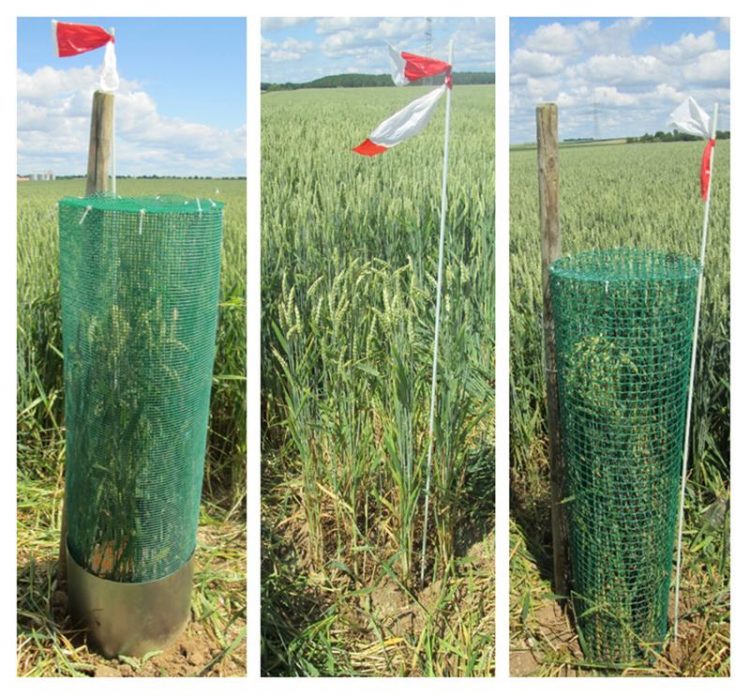Natural enemies reduce pesticide use

Measuring natural pest control (from left): a closed cage without predators, a set-up which all predators can access and a semi-open cage that allows all predators in except for birds. Sarah Redlich
The greater the diversity of crops grown in agricultural landscapes is, the better natural enemies are able to control pests on wheat fields. This is because a varied landscape provides better living conditions for the aphids' natural enemies than a never-ending series of monocultures.
Where wheat is grown on huge areas, ladybirds, spiders, hoverfly larvae and other enemies of aphids don't have enough food in spring, as the pest begins to populate the wheat fields not before May when they start to reproduce. Therefore, the enemies move on to places farther away where there is more abundant supply of food. When pest infestation occurs, the aphids thus encounter ideal conditions since their enemies are low in numbers.
The situation looks different if a variety of different crops grows around a wheat field: Since the natural enemies are around anyway, they are quick to devour the aphids. This effect is all the more pronounced the more diverse the landscape is in a 500 m radius around the field. This is what Sarah Redlich writes in the “Journal of Applied Ecology”; she is an ecologist and a PhD student of Professor Ingolf Steffan-Dewenter at the University of Würzburg in Bavaria, Germany.
18 landscapes around Würzburg investigated
For her study, the scientist picked 18 landscapes in the greater Würzburg area that exhibited a maximum crop diversity. The landscapes were six kilometres in diameter and each had a winter wheat field at its centre. “We chose fields in low-diversity landscapes and fields with high landscape-level crop diversity,” Sarah Redlich explains. For this purpose, the abundance and area of up to 12 crop plant groups in the landscape were calculated, both in a small radius (up to 500 metres) and in a larger radius (3000 metres) around the fields.
She set up two cages each containing 100 aphids on each winter wheat field. The wheat in one of the cages was completely inaccessible. “This cage was designed to keep out all predators. I wanted to know how quickly the aphids reproduce in this case,” Redlich says.
The other cage was coarse meshed, denying only birds access but no other enemies. “I used this set-up to determine the influence birds have on regulating the aphid population in wheat,” the scientist explains.
Thirdly, she demarcated an area that was fully accessible to all predators and again put out 100 aphids there. “I let nature take its course here,” Redlich explains. She then counted the aphids and their enemies at five-day intervals for around two weeks.
After this time, she compared the aphids' population development in the environments with predators to that in predator-free cages. She found that the more varied the landscape around the wheat field is, the fewer aphids thrive on the wheat plants. And what is more, birds proved to be irrelevant as natural enemies of aphids on wheat in the crop system under investigation.
Benefit for farmers
Farmers can also capitalize on this finding: “If they cultivate their fields accordingly, namely increase crop diversity, they may be able to cut down on pesticides which after all damage the natural enemies, too,” the ecologist says. “The fact that the biggest impact of crop diversity was found in a radius of 500 metres around the fields adds further advantages. Often, the adjacent fields are owned by the farmers, leaving them free to decide for themselves which crops to grow there. Within the three-kilometre radius, they would have to agree with their neighbours which crops to grow, which would be more difficult but still feasible,” says Redlich.
Moreover, the finding could help the farmers implement a regulation of the EU Common Agricultural Policy that has been in force since 2014. It stipulates that a greater crop diversity must be grown within the scope of “greening” efforts. This means that farmers need to cultivate “plants that are more diverse in terms of structure and food availability,” says Sarah Redlich. This would require the farmers to create fields of sunflower, rapeseed, beet or similar crops around a field of winter wheat to establish a mix of plants in the landscape that sustains as many enemies of aphids or other pests as possible throughout the year.
Sarah Redlich, Emily A. Martin, Ingolf Steffan-Dewenter: Landscape-level crop diversity benefits biological pest control, Journal of Applied Ecology, DOI: 10.1111/1365-2664.13126
Contact:
Sarah Redlich, Chair of Animal Ecology and Tropical Biology (Zoology III), T.: +49 931 31-82129, sarah.redlich@uni-wuerzburg.de
Prof. Ingolf Steffan-Dewenter, Chair of Animal Ecology and Tropical Biology (Zoology III), T.: +49 931 31-86947, ingolf.steffan-dewenter@uni-wuerzburg.de
Emily Martin, Chair of Animal Ecology and Tropical Biology (Zoology III), T.: +49 931 31-83876, emily.martin@uni-wuerzburg.de
Media Contact
More Information:
http://www.uni-wuerzburg.deAll latest news from the category: Life Sciences and Chemistry
Articles and reports from the Life Sciences and chemistry area deal with applied and basic research into modern biology, chemistry and human medicine.
Valuable information can be found on a range of life sciences fields including bacteriology, biochemistry, bionics, bioinformatics, biophysics, biotechnology, genetics, geobotany, human biology, marine biology, microbiology, molecular biology, cellular biology, zoology, bioinorganic chemistry, microchemistry and environmental chemistry.
Newest articles

A ‘language’ for ML models to predict nanopore properties
A large number of 2D materials like graphene can have nanopores – small holes formed by missing atoms through which foreign substances can pass. The properties of these nanopores dictate many…

Clinically validated, wearable ultrasound patch
… for continuous blood pressure monitoring. A team of researchers at the University of California San Diego has developed a new and improved wearable ultrasound patch for continuous and noninvasive…

A new puzzle piece for string theory research
Dr. Ksenia Fedosova from the Cluster of Excellence Mathematics Münster, along with an international research team, has proven a conjecture in string theory that physicists had proposed regarding certain equations….



